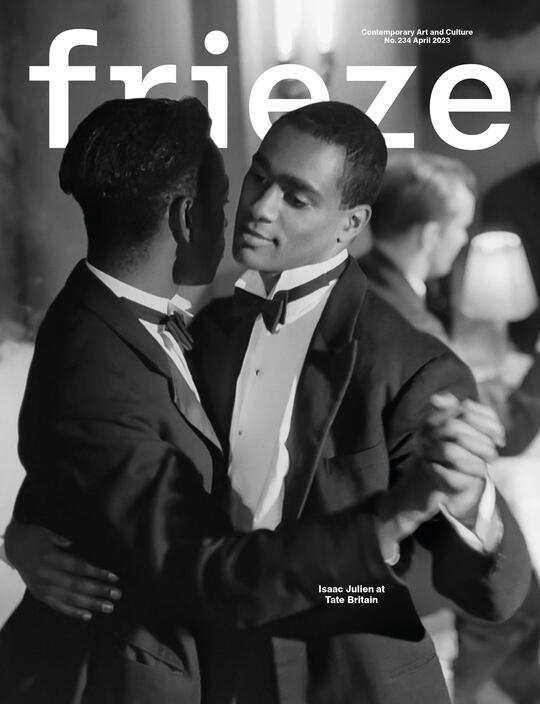Cerith Wyn Evans Reimagines Duchamp and Stella
At Marian Goodman, Paris, the artist’s latest works cite leading figures from twentieth-century art
At Marian Goodman, Paris, the artist’s latest works cite leading figures from twentieth-century art

Cerith Wyn Evans is the type of artist whose engagement with the forms and figures of modern art makes his work a joy to look at – especially for those able to untangle its dense web of references. For his most recent exhibition, ‘no realm of thought…’ at Marian Goodman, Paris – one of a two-part exhibition happening concurrently at the gallery in New York – Evans converses with the likes of Marcel Duchamp, Félix Guattari, Frank Stella and David Tudor.

On the ground floor, the works in the series ‘Neons after Stella’ (2022) buzz with fluorescent white light in the forms of Stella’s ‘Black Paintings’ (1958–60). Although Evans’s citation of the US painter’s most iconic series suggests admiration, his newly created work has a somewhat antagonistic or antithetical relationship to the original: whereas Stella used black paint rhythmed with thin interstices of blank canvas, Evans has employed light to trace the same interstices, consigning the rest to literal negative space. By shaping his thoroughly abstract canvases, Stella made intentionally ambiguous painting-objects. Evans, however, has removed his iterations from the wall and suspended them in the centre of the gallery, effectively eliminating any ambiguity as to their three dimensionality. All of a sudden, Stella’s non-objective, non-referential, relatively silent works, which Evans describes on the gallery’s website as ‘occasioning a bridge to nothingness’, are made to speak through his imaginative détourning of their various constitutive parts.

Downstairs, the phase shift (after David Tudor) (2022) consists of an installation of crushed car windshields hung from large-scale mobiles, which orbit imperceptibly around three suspended columns of neon-tube lighting. The work’s title makes evident the citation of Tudor, whose immersive soundscapes, such as Rainforest (1973), involved objects appended from the ceiling. Their suspension from mobiles in Evans’s version also brings Alexander Calder into the conversation. In turn, the substitution of Calder’s abstract forms for found objects evokes Duchamp, as does the motif of cracked glass, reminiscent of the latter’s enigmatic masterpiece The Bride Stripped Bare by her Bachelors, Even (1915–23). Having spent the majority of his career refusing to converse with other artists or critics, Duchamp revealed, towards the end of his life, another puzzling masterwork – Étant donnés (Given: 1. The Waterfall, 2. The Illuminating Gas) (1946–66) – whose imagery dealt in the common art-historical themes of eroticism, voyeurism and landscape. By comparison, there isn’t much sensuality in Evans’s work, although perhaps this is part of the point. The broken windshields suggest calamity and the modern alienation occasioned by our addiction to screens. In a 2017 interview with The Art Newspaper, Evans stated his desire ‘to get into the thick of what our lived experience is at the beginning of the 21st century. Everyone is looking at a screen, everyone is being controlled by hidden hierarchies, energy power structures, globalization, re-territorialization and the trade of invisible stocks and bonds that we are all somehow subject to.’ Although Evans’s take on our world indulges in a degree of mystification, it does strike close to the heart of a moment that is defined by a series of crises of communication and meaning.

The show’s final installation, Sounding Félix (Paris 8 assemblage) (2022), located in the gallery’s ‘crypt’, is an homage to the French-Italian psychoanalyst and philosopher Guattari. Consisting of several construction-site flood lamps arranged around a gong and stacks of plastic Philippe Starck chairs draped with semi-transparent foil blankets, this piece is the most inscrutable of all. In comparison to the others, it feels a little bit like an afterthought, as if the presence of Evans’s work in Paris necessitated the allusion to a French personality. On the other hand, there is indeed something rhizomatic – a concept first theorized by Guattari and his colleague Gilles Deleuze in A Thousand Plateaus (1980) – about the proliferation of references across Evans’s work, as exemplified by this eclectic exhibition.
Cerith Wyn Evans’s ‘no realm of thought…’ is at Marian Goodman Gallery, Paris, until 25 February and the artist’s coinciding show, ‘… no field of vision’, is at the gallery’s New York space until 4 March.
Main image: Cerith Wyn Evans, Neon after Stella (Study for Valle de los Caidos), 2022, white neon, 8.1 x 2.1 m. Courtesy: the artist and Marian Goodman Gallery; photograph: Rebecca Fanuele
























